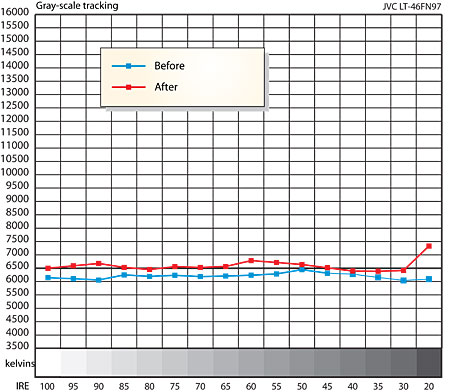JVC LT-46FN97 1080p LCD Flat Panel Television Tests and Calibration
The JVC performed reasonably well on my usual menu of tests for deinterlacing and scaling. Its performance on the various jaggies tests was only fair. While it was marginally slower in locking onto 3/2 pulldown than some displays we have tested, it did lock on. It displayed some line twitter on a 2:2 pulldown test for video-based (not film-based) sources. But I was never bothered by artifacts with real program material on anything but the worst analog cable sources.

Viewing multiburst luminance response patterns from my AccuPel HDG-3000 test pattern generator revealed that the JVC was essentially perfect out to the maximum frequencies required for 480i (6.75MHz) and 480p (13.5MHz) standard definition in both HDMI and component. It was also good in component 1080i, though a little noise and unevenness was evident on the highest burst (37.1MHz), along with a response that was rolling off visibly at that frequency. The 1080i HDMI multibursts also held up to the 37.1MHz maximum with only a slight unevenness in the highest frequency burst. The 720p bursts, with both component and HDMI, were also excellent, though both showed some rolloff at 37.1MHz (the more so with component than HDMI).
The color resolution was also more than adequate to support the set's fine overall resolution. At a number of resolutions, with both HDMI and component, there was noticeable, non-defeatable edge sharpening visible on vertical lines in a sharpness test pattern (even with the Detail control at its -30 lower limit). This oversharpening was essentially insignificant in the Theater setting, but quite obvious in the Standard, Dynamic, and Game modes.
The RGB color points were comfortably close to the ATSC (high-definition) standard. Green was very accurate, and blue, in particular, closer to the blue-purple of the standard than most displays I've tested.
The JVC would not reproduce below black with an HDMI source, but did do below black in component. It did above white on both HDMI and component. Overscan averaged about 2.5% in all resolutions and in both HDMI and component.
As noted earlier, JVC did not provide workable service menu access information prior to the initial posting of this review. But we have subsequently received it, and have now performed a full calibration. The factory High Color Temperature setting measured close to 8000 Kelvins, the Low setting was comfortably close to the D6500 standard. A red shift dropped the color temperature to under 6500 Kelvins over much of the brightness range, but not enough to be visibly intrusive in normal viewing. But following a full calibration, the set measured even closer to the D6500 standard, apart from a blue shift below 30IRE. The before and after results are now shown in the chart.
I measured the JVC's contrast ratio with several different settings of the Energy Saver Mode (backlight). In all cases the peak contrast was approximately the same. My preferred backlight setting of -25 produced a peak contrast ratio of 636:1 (36.25foot-Lamberts peak white/0.057fL video black). At a backlight setting of zero, the peak contrast measured 677:1, with a peak white level 53fL, but the black level also increased in near lockstep, to 0.079fL. Increase the backlight to maximum, incidentally, and you'll get a contrast ratio of 620:1 and a peak white output of nearly 81fL.
- Log in or register to post comments



































































